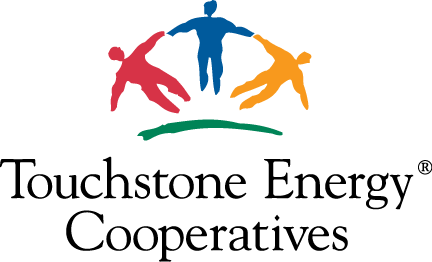Welcome to our solar inquiry page. Please review the information in the FAQ section below to determine if solar is right for you. If you’re interested in leasing panels through the OurSolar community solar program, learn about OurSolar here and contact us to start the leasing process.
Important: If you are working with a solar company that will be performing the installation or filling out application documents in relation to your request for solar, please fill out the Solar Inquiry Form at the bottom of this page.Steps to get connected
Review the information below, and talk to us to get the additional information you need to make an informed decision.
1. Complete a design plan
2. Submit design plan and application
3. Application Review
4. Sign Agreements
5. Install Your System and Request an Inspection
6. Install and test
Solar FAQ
Does Consolidated Cooperative have any programs for residential customers related to alternative energy (wind, solar)?
Yes, Consolidated Cooperative has three.
The first is OurSolar, a community-solar field located at our Delaware office on St. Rt. 521. OurSolar represents the cooperative’s long history of members working together to bring products and services to ourselves and our communities more cost-effectively than we can as independent individuals. See https://www.oursolar.coop/consolidated/ for program details and availability.
The second is a “net-metering” option for members who wish to install their own, small renewable systems (typically solar or wind power and subject to capacity and other limitations). Consolidated will accept those systems’ excess output and credit the member’s account for the energy they provide, within limitations.
Third and last, larger renewable systems may be interconnected; contact us, however, for details.
Does Consolidated install solar systems or recommend companies that do?
No, Consolidated does not work beyond each member’s meter. However, we will review your application and plans for compliance with our requirements. We do not recommend solar installers, but we do recommend that you do do thorough research before entering into any contracts. We are available to answer questions as our members talk to prospective installers.
Does Consolidated require a third-party inspection?
Yes, Consolidated requires the installation to be inspected by a Certified PVSI or Certified ESI. We will also complete a site inspection to see that the system is installed as submitted.
What is “net metering”?
“Net metering” generally refers to the concept of utility customers receiving retail pricing for renewable energy that they generate back onto the utility system. By paying retail prices for what is essentially a wholesale service, a utility that “net meters” pays those customers not only for generating the power, but also for the substantial cost of transmitting and delivering that power to other customers, even though the utility still must transmit and deliver the customer-generated power.
In the case of a not-for-profit, member-owned cooperative like Consolidated, there is only one source for the extra costs incurred from paying twice for delivering energy (once to the net-metered customer and again to deliver the energy). That source is the other members of the cooperative; there are no shareholders or profits from which those added costs can be paid.
Why does Consolidated “net meter”?
Net-metering policies were developed to encourage customers to invest in renewable generation systems and help spur development of those systems. Some utilities in Ohio were mandated to provide net-metering programs; however, electric cooperatives were exempted from that requirement since cooperatives are not-for-profit, self-governed, and largely self-regulated.
Many cooperatives, including Consolidated, chose to participate at some level. Consolidated is neither “for” nor “against” any source of power, per se. In balancing the needs and wishes of 15,000 diverse individuals, we felt that providing a limited net-metering option would serve those members who believe strongly in promoting renewable energy sources and those who believe strongly that we should instead keep costs low.
Will I be able to “make money” net metering?
With the ever-changing landscape of system costs, tax subsidies, and other incentives, Consolidated cannot predict individual financial outcomes. However, we intend the net-metering program to provide a way for members to offset their energy costs using their renewable sources, not to provide revenue for members with those sources.
Systems that generate more energy in one 12-month period than the member purchases from Consolidated in the same time are generally too large to qualify for net metering. In the exceedingly unlikely case that the sun shines more excessively than typical for our region, net-metered accounts will not be eligible for reimbursements – read further for details, or better yet, contact us so we can explain it better than a short FAQ response can.
What are the limitations on net-metering credits?
An example will follow to help, but the maximum amount of energy for which a member can be credited at the net-metering rate in a given billing cycle (generally one month) is the amount of energy Consolidated delivers to that member in that same billing cycle. Any energy produced by the member above the amount delivered by Consolidated to the member is credited at the current “Avoided Cost” rate; if the dollar amount of those credits exceeds the member’s total bill for that billing cycle, the dollar difference is carried forward to the subsequent bill, so long as your total credits for a 12-month period cannot exceed the member’s total charges for that period.
An example of how net metering works
For example, and using easy numbers instead of realistic amounts, let’s say a member with an interconnected renewable source purchases 100 kWh from Consolidated in a particular month. We’ll consider three scenarios for how much energy is generated back to Consolidated in that month: 1) the system generates less than 100 kWh, 2) the system generates a little more than 100 kWh, and 3) the system generates significantly more than 100 kWh.
- If the system generates 80 kWh in that same month, those 80 kWh will be credited back to that month’s bill at the retail rate, creating a bill equivalent to the member’s purchasing only 20 kWh that same month.
- If the system generates 110 kWh, the first 100 kWh will be credited at the retail rate, and the additional 10 kWh will be credited at the avoided-cost rate. We’ll assume that the total dollar value of credits remains less than the member’s total bill for the month, and no further considerations apply.
- If the system generates significantly more than the 100 kWh, the first 100 of those will be credited at retail rate, and the additional will be credited at the avoided-cost rate. If the total amount of credit (100 kWh at retail rate plus remainder at avoided-cost rate), exceeds the member’s total bill for the month, the amount that the dollar value of the credit exceeds the total bill cost will be carried over to the following month, and the current month’s bill will be $0.
- However, the total dollar value of credits over the prior 12 months cannot exceed the total amount billed over those same 12 months. Credits above this limit will be forfeited; however, such a situation is unlikely.
What are the limitations on what Consolidated will net meter?
Besides the financial limitations on credits explained elsewhere, there are some limitations on the locations and sizes of systems that will qualify for net metering. It’s best to contact us to be certain of your specific situation. Systems larger than the limit may still be interconnected; however, they will not be eligible for net metering.
Additionally, the physics involved in power delivery systems can impose limitations on the number and sizes of customer-owned generating systems. In the unlikely case that Consolidated’s power-delivery system cannot accept generation sources at your location, Consolidated reserves the right to deny its interconnection.
Very large systems must be coordinated with and governed by our wholesale power provider, Buckeye Power. Consolidated will facilitate the necessary interactions.
What is the “Avoided Cost” rate?
The Avoided Cost rate reflects the full cost of generating the energy, without adding the costs for delivering it to other members. This rate is determined annually by our wholesale provider, Buckeye Power, based upon the prior year’s experience.
I have offset my entire energy usage for the month and have been credited for the excess energy I generated; why do I still have to pay a “service availability charge?”
All customers are billed a service charge that we use to cover our fixed costs of billing, meter reading, poles, wires, transformers and other necessary equipment, including maintenance. The credits you receive for energy you make available to Consolidated beyond what you use from Consolidated are applied up to the amount of your total electric bill. If your credits exceed your total bill for the billing period, the additional dollar value is carried forward to your subsequent bill, so long as your total credits for the prior 12 months do not exceed the total amount you were billed over that period.
Why don’t you pay me the same rate for my energy that I pay you for yours?
The answer here is two-part.
First, until you have offset all the energy you purchase in a billing cycle (generally about one month) you are receiving credit at the exact same rate as you pay – the “net-metered” amount.
Second, for any energy you provide to Consolidated’s system above the amount you use in a billing period, you receive the “avoided cost” rate. Avoided cost is essentially what the cooperative avoided paying our wholesale-energy supplier for generating the electricity.
Why is your price different from other utilities?
Each utility is a separate entity with different operating costs, different wholesale energy costs, and many other factors that impact rates. Each utility decides its own strategies and methodologies; Consolidated can answer only about its own.
Will I have an electric bill if I have solar panels on my house?
If you are connected to Consolidated’s system, then you will receive a bill. Every account has a service fee that at least helps cover the cost of our operating and maintaining your connection before we deliver the first kilowatt-hour of energy. It is possible to produce enough excess energy in a billing cycle that the amount we pay you could offset all fees we charge you so that your bill totals zero. If your credits are greater than your bill for a billing cycle, the additional dollar credit is carried forward and applied to your subsequent bill.
I have a system already; why am I not getting the return I was told to expect?
We do our best to encourage our members to check with us, directly, before they make significant decisions like this. We find, however, that many, if not most, expectations are based on off-the-shelf analyses that others provide that do not use our specific rates and policies. Commonly, those analyses utilize “averaged” rates rather than actual rates, misrepresenting the true value of the energy that the systems might produce. Especially since most of the rate structures we have seen for electric utilities often comprise several different components, they can be complicated to model and analyze accurately.
Although we itemize our billing components, the calculations for our residential rates are comparatively straightforward. We are happy to speak to you about your specifics; ideally, it would have been before you committed to your installation so that you could have had better information upon which to base your decisions.
Why do you charge a different rate for “net-metered” accounts than the standard residential rate?
In short, the two rates result in the same total monthly bill for most members, and effectively are not much different.
Although the components of the two rates are different, both rates calculate out to about the same total cost for members who generally use somewhere around the average amount of energy used by our typical residential members. Those two rates are two paths to the same (or very similar) results. Our “net-metering” rate, however, more accurately calculates the true cost-drivers for delivering energy to (and accepting it from) our members.
Charging members who generate their own energy based upon the standard residential rate, however, would create the situation where our traditional members (those who do not generate energy) would significantly and unfairly subsidize those members who do generate their own. Using the “net-metering” rate still does create a small amount of that imbalance; however, the effects for each “traditional” member are almost negligible with so comparatively few “net-metering” accounts.
If we were to standardize on one rate (we continue to migrate slowly in that direction and had started doing so long before our first “net-metering” member), it would be the “net-metering” rate. However, since both rates generally have the same end result for most members, we accept, for now, the consequences of the apparent disparity.
I just installed my system; how do I get it interconnected?
Before we can safely interconnect with your system, you’ll have to give us the details of your system so we can determine what will be needed. There are safety requirements that you may need to add or change if we have not already worked with you, and there may be important information we need to give you.
Although it is very unlikely, there may be operational or other limitations that prevent us from interconnecting.
It is likely there will be a nominal fee from us to cover our costs of analyses and coordination, once a formal application is made. As always, questions and answers are free.
I’m considering installing a system. What do I do next?
First, read through the information here to understand the process of interconnecting your system with Consolidated’s lines. Next, contact us so you can share with us details about the system you are considering, and we can help you see what effects it is likely have on your bill.
It is likely there will be a nominal fee from us to cover our costs of analyses and coordination, once a formal application is made. As always, questions and answers are free.
Who should I contact if I have more questions relating to solar for the home?
Contact Consolidated’s Service Specialists at 1-800-421-5863 or send an email to renewableenergy@consolidated.coop





